

The Industrial Revolution: Why Britain Got There First. Painting depicting the opening of the Liverpool and Manchester Railway in 1830, the first inter-city railway in the world.Many observers of modern social science are convinced of the maxim: 'There are three kinds of lies: lies, damned lies, and statistics'.
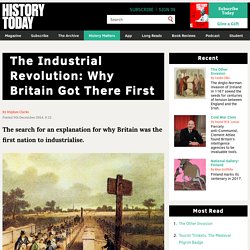
Yet good historical scholarship has always used statistics as the antidote to the ‘damned lies’. This is especially useful with the Industrial Revolution, where wild theories dominate. Below I examine three famous theories of the Revolution and show why they do not tell us the whole story. Underpinning my analysis is the recent work of Professor Nicholas Crafts, Professor of Economics and Economic History at the University of Warwick. In November the Legatum Institute welcomed Professor Crafts to explore the question: ‘why Britain got there first?’ What do we understand by ‘Britain was first to industrialise’?
Second, the ‘great divergence’ had already occurred by the time Britain was industrialising. Why was Britain first? The industrial revolution in global context. Dampfmaschine: Funktion der Dampfmaschine als Animation. Dampfmaschine, Steam Engine, Maquina de Vapor, Motor a vapor, Dampmaskine, 蒸気機関 (James Watt 1769) Animation Download Flash (swf) Animation Download PC (exe) Die Dampfmaschine: So begann der Stromboom Mit der Erfindung des elektrischen Lichts und der flächendeckenden Stromversorgung setzte Anfang des letzten Jahrhunderts der Stromboom ein.

Heute können wir uns kaum vorstellen, wie die Welt ohne Elektrizität aussah. Erste Schritte zur Erzeugung von elektrischem Strom wurden mit der Dampfmaschine unternommen. The Worst Jobs in History - The Dark Age - Part 1. Industrial Revolution. Web Links - The Industrial Revolution. Childhood Lost: Primary Source Set. Primary Sources - Industrial Revolution. Primary Sources: The Industrial Revolution. The Industrial Revolution in the United States - Primary Source Set. Primary Source Documents - Industrial Revolution in Europe. WomenPreindustrialSocietyEurope. Preindustrial Societies: The Birth of Inequality. History - British History in depth: Who Wants to Be a Cotton Millionaire? The impact of the railways. Textiles industry. Sometimes a series of technological improvements causes dramatic change in the nature of society and in the way work is organised.
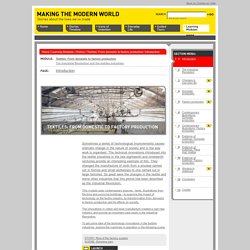
The technical innovations introduced into the textile industries in the late eighteenth and nineteenth centuries provide an interesting example of this. They changed the manufacture of cloth from a process carried out in homes and small workshops to one carried out in large factories. Internet History Sourcebooks. Industrial Revolution See Main Page for a guide to all contents of all sections.

Guns Germs & Steel: The Show. Overview. Overview Based on Jared Diamond's Pulitzer Prize-winning book of the same name, Guns, Germs and Steel traces humanity's journey over the last 13,000 years – from the dawn of farming at the end of the last Ice Age to the realities of life in the twenty-first century.
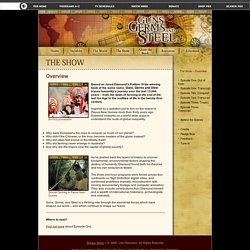
Inspired by a question put to him on the island of Papua New Guinea more than thirty years ago, Diamond embarks on a world-wide quest to understand the roots of global inequality. Guns Germs and Steel - Out of Eden - 1/3 HD. Industrial Revolution Movies. Lesson Series Industrial revolution. BBC Game: Who Wants to Be a Cotton Millionaire? Animation of How a Steam Locomotive's Boiler Works. Steam Engine Operation - How Steam Engines Work. The following diagram shows the major components of a piston steam engine.

This sort of engine would be typical in a steam locomotive. Reasons for the Industrial Revolution I IT'S HISTORY. Revolution in the Textile Industry. Video spinning machine. Historiographical debates. A huge topic!
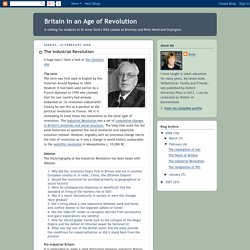
Have a look at this fantastic site. The termThe term was first used in English by the historian Arnold Toynbee in 1884. However it had been used earlier by a French diplomat in 1799 who claimed that his own country had already embarked on ‘la révolution industrielle’. The Source-Child Labor. The Source Source Home l Introduction l Connecting to Illinois l Places to Go Primary Sources to See TPS EIU Staff Pick l Primary Sources in the Classroom l loc.gov l PDF with Images This publication is created to be a source of information and inspiration for teachers as they incorporate Library of Congress digitized primary sources and resources into instruction by Teaching with Primary Sources at Eastern Illinois University.
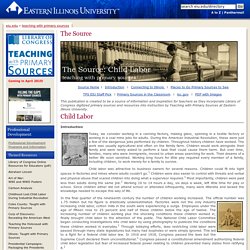
Child Labor Introduction Today, we consider working in a canning factory, making glass, spinning in a textile factory or working in a coal mine jobs for adults. Child labor was attractive to business owners for several reasons. Why was the Industrial Revolution British? Robert C.

Allen 15 May 2009 Why did the Industrial Revolution take place in eighteenth century Britain and not elsewhere in Europe or Asia? Answers to this question have ranged from religion and culture to politics and constitutions. The British Industrial Revolution in Global Perspective. Coal, Steam, and The Industrial Revolution: Crash Course World History #32. The Worst Jobs In History - 2x03 - Industrial. BBC documentary Industrial Revolution (1 hr)
TAAPWorld - The Environmental Impact of the Industrial Revolution. The Industrial Revolution changed the relationship between humans and their environment.
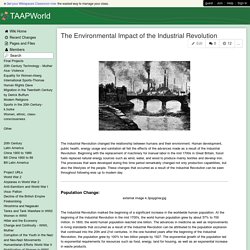
Human development, public health, energy usage and sanitation all felt the effects of the advances made as a result of the Industrial Revolution. Beginning with the replacement of machinery for manual labor in the mid 1700s in Great Britain, fossil fuels replaced natural energy sources such as wind, water, and wood to produce mainly textiles and develop iron. The processes that were developed during this time period remarkably changed not only production capabilities, but also the lifestyles of the people. These changes that occurred as a result of the Industrial Revolution can be seen throughout following eras up to modern day. Population Change: Online text book Industrial Revolution.
What was Pre-Industrial Society Like? How much did the Industrial Revolution change society? Did the Industrial Revolution improve life for most people? The only way to investigate these questions is to compare and contrast industrial with pre-industrial society. To do so, we’ll start with pre-industrial life and use it as a baseline standard to contrast to the industrial era after 1750. In doing so, we will also discover a number of ways that the roots of industry run deep into the pre-industrial era. For starters, the pace of change in preindustrial society was extremely slow. Daily life in pre-industrial times changed very little for Europeans. Remarkable Photos of Child Labor During the Industrial Revolution - Cube Breaker.
The industrial revolution brought about swift, significant change to life as the people of the time knew it. Workers once used to subsistence farming in rural areas moved to cities to work in factories in droves. The rapid movement was not without strife. Conditions were dirty, crowded, and often extremely dangerous. The soaring rise in production levels could not adequately be met by adults and desperate parents struggling to survive and put food in their children’s mouths put them to work alongside them in the factories.
Conditions were brutal for the children. Punishment for boys and girls who did not meet expectations ranged from verbal to physical abuse. Industrial Revolution Overview. Industrial Revolution. Jobs of the Industrial Revolution Research Task Lesson - Year 9. This lesson plan will look at the development of jobs during the Industrial Revolution and the changes that took place. The Industrial Revolution, 1750-1914. Year level: Year 9 Australian Curriculum: History reference – Depth Study 1 Making a Better World? The Industrial Revolution, 1750-1914 option The learning sequence models an approach that encourages inquiry and provides a significant amount of source material for students to use.
The goal is to ensure that students are able to explore the topic in some depth and are given the opportunity to deal with an appropriately complex range of detail and issues. Year 9 Industrial Revolution. Year 9 Industrial Revolution Capital and Labour (Punch Archive) retrieved from 3/5/12 This subject guide is still under construction and so far has taken 8 hours to resource (and I have been having layout issues!). The Industrial Revolution is a HUGE topic that I remember being very boring when I was at school! Isn’t it wonderful the internet came along to liven things up. Australian Curriculum.